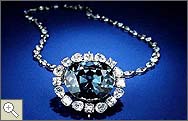|
|
 |
 |
 |
|
Hope Diamond |
|
Minerals and Crystals
-
Gems
-
Hope Diamond
|
 |
 |
 |

A Gem of a Story: The Hope Diamond
The Hope Diamond lay hidden below the Earth's surface for more than a billion years before it became one of the most famous of all gems. Today the Smithsonian displays it in the Janet Annenberg Hooker Hall of Geology, Gems, and Minerals in the National Museum of Natural History. The Hope Diamond served as the model for the lost jewel in the movie Titanic and has a history dating back to the 17th century. In 1668 Jean Baptiste Tavernier, a French traveler and gem merchant, sold a blue diamond weighing 112 3/16 carats (more than twice the size the diamond is today) to King Louis XIV of France. Tavernier would say only that the diamond had come from India. Louis XIV had the gem recut and set as a pendant as part of the crown jewels.
The diamond was stolen in 1792 during riots associated with the French Revolution. The diamond resurfaced in England in 1812, cut to its current shape and size of 45.52 carats. In 1830 Henry Philip Hope, a London banker and gem collector, bought the stone, which was then named after him. After leaving the hands of the Hope family in 1901, the diamond had a succession of owners, some of whom delighted in telling of a "curse" the stone placed on its caretakers. In 1958 distinguished New York jeweler Harry Winston presented the Hope Diamond to the Smithsonian, where it currently resides, on view to the public.
|
 |
 |
 |
 |

Hope Diamond © 1993 Smithsonian Institution
|
 |
 |

|
 |
 |
 |
|




|
|
|

